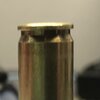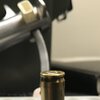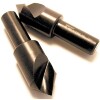JCSC
Member
I know this has been discussed before, but I am scratching my head.
I was looking for a plinking load for the AR and reviewed several forums and handbooks, with the intention if using H335.
I loaded a first batch of 10 pcs to take along with me to the range and see if it would cycle decent. This was an AR pistol, 10.5" barrel. PSA factory barrel / BCG kit. Note that the gold primer is a factory range brass I grabbed. not from this gun, but it looked like what I would expect to see.
The pictures are from a second batch of H335 at 23.7gr. Everything I have read says people use 25+ without issue.


The 10 pcs consisted of mixed range brass, full length sized, trimmed, deburr ID/OD, swagged and chamfered. Powder was 24 gr H335 measured on my RCBS beam scale. I checked zero before and after as usual and weighed one of the 55gr Hornady FMJ-BT WC #2267, just as a habit. Primers are CCI 400 with a COL of 2.210/2.214 range.
My primers are smashed flat, as if they flowed into the primer pocket chamfer. No cratering, or raised areas around the pin, but not healthy looking.
For my own sanity, I took my 30 caliber hornady comparator as, to check a consistent shoulder length on these 6 fired pcs. The reference number was 1.499 / 1.500. I checked several resized pcs to see if I was pushing back the shoulders. they ranged 1.494/1.493.
I have some more 400 primers as well as some rem 7-1/2.
Thoughts?
I was looking for a plinking load for the AR and reviewed several forums and handbooks, with the intention if using H335.
I loaded a first batch of 10 pcs to take along with me to the range and see if it would cycle decent. This was an AR pistol, 10.5" barrel. PSA factory barrel / BCG kit. Note that the gold primer is a factory range brass I grabbed. not from this gun, but it looked like what I would expect to see.
The pictures are from a second batch of H335 at 23.7gr. Everything I have read says people use 25+ without issue.


The 10 pcs consisted of mixed range brass, full length sized, trimmed, deburr ID/OD, swagged and chamfered. Powder was 24 gr H335 measured on my RCBS beam scale. I checked zero before and after as usual and weighed one of the 55gr Hornady FMJ-BT WC #2267, just as a habit. Primers are CCI 400 with a COL of 2.210/2.214 range.
My primers are smashed flat, as if they flowed into the primer pocket chamfer. No cratering, or raised areas around the pin, but not healthy looking.
For my own sanity, I took my 30 caliber hornady comparator as, to check a consistent shoulder length on these 6 fired pcs. The reference number was 1.499 / 1.500. I checked several resized pcs to see if I was pushing back the shoulders. they ranged 1.494/1.493.
I have some more 400 primers as well as some rem 7-1/2.
Thoughts?











